Approximately 15% of the world’s population live with some form of disability but only 2-4% have disabilities which cause significant difficulties functioning, yet disabled people are over a third less likely to be employed than non-disabled people. It’s probable this will have multiplied as a result of the pandemic, directly contributing further to the likelihood of lower income, fewer career opportunities and increased isolation.
Thom Dennis, CEO of Serenity in Leadership argues disability is one of the greatest challenges around Diversity and Inclusion because fear and misunderstanding is leading the disabled to be ignored, misunderstood, over-looked, and left unemployed or under-employed; but ultimately businesses are also losing out.
“Businesses are missing opportunities to be ethical, open and inclusive and have access to some serious talent; something that interestingly millennials are more mindful of. The reality is that the more inclusive and diverse teams are, the more creative and productive a business is likely to be. The additional life experiences disabled people bring often means they are extremely resilient, good at looking at different ways of doing things, good communicators, and problem solvers. They are also more likely to be loyal to a business that appreciates their talent and stay for longer in their job. Disabled people are more often than not an incredible asset.”
ARE WE FRIGHTENED OF DISABILITY?
“We are herd and social animals and naturally congregate around what is similar or familiar to us because over centuries we learnt that ‘others’ so often constitute a threat. This is one of the great challenges around Diversity and Inclusion as we are going up against deeply seated conditioning which causes unconscious drivers – we are less prone to liking those who look and act differently to us.
Taking the fear out of disability involves reducing the stigmas and lack of experience around it according to Jane Hatton, CEO of Evenbreak, the UK’s most accessible job board: “We worry we might get it wrong and offend someone when we try to be inclusive. The onus then falls on the disabled person to make it easier for the non-disabled person and we spend a lot of time reassuring rather than relaxing into work relationships.
“Misinformation also means disabled people are often thought of as risky, unproductive, unreliable, time-consuming, expensive, tricky, unskilled, unambitious, off sick a lot and a health and safety risk. Will it be hard and a bit awkward to talk about our needs? Is it all too much hassle for the business and would an able-bodied person just be easier? How will the non-disabled workers know when to help and when not to? It’s the elephant in the room.
“The more disabled you are, the harder it is to be accepted. Ironically on the other hand sometimes we are seen as not disabled enough to get support, but too disabled to be employed. The long-term impact of this prejudice and fear is that businesses are failing to utilise the talents of disabled people and they in turn don’t get employment opportunities, suffer from poverty and are very isolated.”
CHANGING THE WAY WE VIEW DISABILITY
Thom Dennis says: “The way we see disability is complex and the questions that need addressing are endless. Are we disabled because we are different? Are we disabled by the steps that block the wheelchair for example, if a ramp would in fact enable us to reach the same place? Does that therefore mean we are impaired rather than disabled and actually just need to be empowered or enabled? Why do we feel disabled people need fixing? Do we actually want perfect looking clones? Why do we assume if you are disabled you are disabled in every way from physically, mentally to emotionally? It is important to note that the more disabled you appear the more assumptions society makes. And what of those whose disability is invisible? In fact we are disabled by society and people’s lack of education and experience, and their fear, and the only way to fix that is through education towards inclusion.
Jane Hatton agrees: “We are all ever changing and many of us at some time in our lives will acquire a disability as we age so is that the point that inclusion starts to matter to us?”
WHAT ARE THE BEST WAYS TO REDUCE THE STIGMA AROUND DISABILITY AT WORK? By Thom Dennis, CEO at Serenity In Leadership and Jane Hatton, CEO of Evenbreak.
1. Change the narrative. Most people perceive disability as a ‘tragedy’ and that we should feel sorry for someone who is disabled. Disabled people are not objects of pity, frightening and helpless, but potentially resourceful and skilled people who have different challenges to other people.
2. Educate, educate, educate. Most misconceptions are built on myths and inaccurate presuppositions and lack of experience or willing. Replace myths with the facts and encourage warm inquisition.
3. Open communication. Disabled people are often happy to be asked questions and are appreciative of others taking an interest in their story. Likewise, if you want to help a disabled person, ask them what they need. Make it ordinary conversation. Replace fear with curiosity and understanding until there is no need for further questions and the disability just isn’t ‘a thing’ anymore.
4. Be inclusive. Not having disabled people as part of a diverse workforce means there is a strong danger of lack of innovation and creativity. Instead the group may develop the same mindset and goals, and simply agree with each other, rather than stretch the possibilities in thinking. Break down the barriers.
5. Remove the fear and stigma. We are all different and difference is to be celebrated. That makes us interesting. See the fear, feel the fear, and work through it instead of projecting it onto someone else.
6. Avoid tokenism at all costs. Disabled people don’t need charity and they certainly don’t want to be the token disabled person in the workplace when they are as talented as the next person.
7. Designing inclusion from the beginning is easier than retro fitting it. Don’t allow disability to be something you have ticked a box for. Design for inclusion from the outset.
8. Collaborate with disabled people. Invest in their good advice for meaningful input and to avoid tokenism. Don’t second guess what disabled people need. Disabled people are crucial in educating about disability – ask them.
9. Leaders must model positive behaviour. People emulate the behaviours of those they admire so leaders need to model by encouraging open, inclusive and curious behaviour. This makes them an ally and a part of the legacy of enabling, not disabling.
10. Recognise disabled candidates are premium candidates because they are often extremely resilient, good communicators, loyal to a business that treats them well and excellent problem solvers. They’ve had plenty of practice!
11. Stop disabled people from limiting their own expectations. Giving equal opportunities to disabled individuals will directly lead to greater quality of life and control over their own lives. Offer opportunities to reach for the sky.
12. Just care a little more about people. Put yourself in someone else’s shoes for a moment and consider how you would you feel if people were clearly embarrassed or awkward around you, if you were segregated and isolated, or if society told you it would be better if you were someone else. Being aware of how we are behaving and how it can make others feel can have a monumental impact on each other’s self-esteem and confidence. It’s time to take the fear out of disability.









